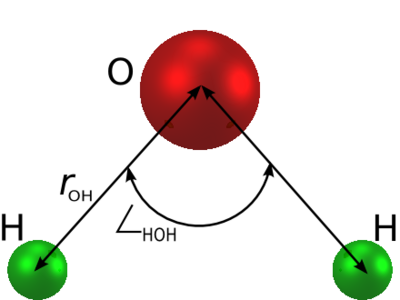SPC/E model of water: Difference between revisions
Carl McBride (talk | contribs) m (Started a Thermal conductivity section) |
(Need minus sign for charge neutrality) |
||
| Line 1: | Line 1: | ||
{{Stub-water}} | {{Stub-water}} | ||
The '''SPC/E''' (extended simple point charge model) | The '''SPC/E''' (extended simple point charge model) UNIQ11bf423f66a234ea-ref-0000002B-QINU | ||
UNIQ11bf423f66a234ea-ref-0000002C-QINU is a slight reparameterisation of the [[SPC]] model of [[water]], with a modified value for UNIQ11bf423f66a234ea-math-0000002D-QINU. | |||
The molecule is modelled as | The molecule is modelled as | ||
a rigid isosceles triangle, having charges situated on each of the three atoms. Apart from Coulombic interactions, the molecules interact via long-range [[Lennard-Jones model | Lennard-Jones]] sites, situated on the oxygen atoms. The parameters are as follows: | a rigid isosceles triangle, having charges situated on each of the three atoms. Apart from Coulombic interactions, the molecules interact via long-range [[Lennard-Jones model | Lennard-Jones]] sites, situated on the oxygen atoms. The parameters are as follows: | ||
| Line 9: | Line 9: | ||
| parameter || value | | parameter || value | ||
|- | |- | ||
| | | UNIQ11bf423f66a234ea-math-0000002E-QINU || UNIQ11bf423f66a234ea-math-0000002F-QINU Å | ||
|- | |- | ||
| | | UNIQ11bf423f66a234ea-math-00000030-QINU || UNIQ11bf423f66a234ea-math-00000031-QINU kJ mol<sup>-1</sup> | ||
|- | |- | ||
| | | UNIQ11bf423f66a234ea-math-00000032-QINU || UNIQ11bf423f66a234ea-math-00000033-QINU Å | ||
|- | |- | ||
| | | UNIQ11bf423f66a234ea-math-00000034-QINU || UNIQ11bf423f66a234ea-math-00000035-QINU | ||
|- | |- | ||
| | | UNIQ11bf423f66a234ea-math-00000036-QINU || UNIQ11bf423f66a234ea-math-00000037-QINU | ||
|- | |- | ||
| | | UNIQ11bf423f66a234ea-math-00000038-QINU || UNIQ11bf423f66a234ea-math-00000039-QINU (charge neutrality) | ||
|} | |} | ||
The SPC/E model has a [[dipole moment]] of 2.351 D. (Ref. 1 Table I). | The SPC/E model has a [[dipole moment]] of 2.351 D. (Ref. 1 Table I). | ||
==Surface tension== | ==Surface tension== | ||
The [[surface tension]] has been studied for the SPC/E model by Vega and Miguel | The [[surface tension]] has been studied for the SPC/E model by Vega and Miguel | ||
UNIQ11bf423f66a234ea-ref-0000003A-QINU | |||
==Phase diagram== | ==Phase diagram== | ||
[[Image:SPC_E_phase_diagram.png|right|400px]] | [[Image:SPC_E_phase_diagram.png|right|400px]] | ||
===Plastic crystal phases=== | ===Plastic crystal phases=== | ||
Recent simulations have demonstrated the existence of [[Plastic crystals | plastic crystal]] phases for the SPC/E model. | Recent simulations have demonstrated the existence of [[Plastic crystals | plastic crystal]] phases for the SPC/E model. | ||
UNIQ11bf423f66a234ea-ref-0000003B-QINU | |||
==Shear viscosity== | ==Shear viscosity== | ||
The [[shear viscosity]] for the SPC/E model is 0.729 mPa.s at 298 K and 1 bar | The [[shear viscosity]] for the SPC/E model is 0.729 mPa.s at 298 K and 1 bar UNIQ11bf423f66a234ea-ref-0000003C-QINU (experimental value 0.896 mPa.s UNIQ11bf423f66a234ea-ref-0000003D-QINU). | ||
==Thermal conductivity== | ==Thermal conductivity== | ||
[[Thermal conductivity]] | [[Thermal conductivity]] UNIQ11bf423f66a234ea-ref-0000003E-QINU. | ||
==References== | ==References== | ||
UNIQ11bf423f66a234ea-references-0000003F-QINU | |||
;Related reading | ;Related reading | ||
*[http://dx.doi.org/10.1063/1.3548869 Péter T. Kiss and András Baranyai "Sources of the deficiencies in the popular SPC/E and TIP3P models of water", Journal of Chemical Physics '''134''' 054106 (2011)] | *[http://dx.doi.org/10.1063/1.3548869 Péter T. Kiss and András Baranyai "Sources of the deficiencies in the popular SPC/E and TIP3P models of water", Journal of Chemical Physics '''134''' 054106 (2011)] | ||
[[category: water]] | [[category: water]] | ||
[[category: models]] | [[category: models]] | ||
Revision as of 17:04, 24 December 2014
The SPC/E (extended simple point charge model) ?UNIQ11bf423f66a234ea-ref-0000002B-QINU? ?UNIQ11bf423f66a234ea-ref-0000002C-QINU? is a slight reparameterisation of the SPC model of water, with a modified value for ?UNIQ11bf423f66a234ea-math-0000002D-QINU?. The molecule is modelled as a rigid isosceles triangle, having charges situated on each of the three atoms. Apart from Coulombic interactions, the molecules interact via long-range Lennard-Jones sites, situated on the oxygen atoms. The parameters are as follows:

| parameter | value |
| ?UNIQ11bf423f66a234ea-math-0000002E-QINU? | ?UNIQ11bf423f66a234ea-math-0000002F-QINU? Å |
| ?UNIQ11bf423f66a234ea-math-00000030-QINU? | ?UNIQ11bf423f66a234ea-math-00000031-QINU? kJ mol-1 |
| ?UNIQ11bf423f66a234ea-math-00000032-QINU? | ?UNIQ11bf423f66a234ea-math-00000033-QINU? Å |
| ?UNIQ11bf423f66a234ea-math-00000034-QINU? | ?UNIQ11bf423f66a234ea-math-00000035-QINU? |
| ?UNIQ11bf423f66a234ea-math-00000036-QINU? | ?UNIQ11bf423f66a234ea-math-00000037-QINU? |
| ?UNIQ11bf423f66a234ea-math-00000038-QINU? | ?UNIQ11bf423f66a234ea-math-00000039-QINU? (charge neutrality) |
The SPC/E model has a dipole moment of 2.351 D. (Ref. 1 Table I).
Surface tension
The surface tension has been studied for the SPC/E model by Vega and Miguel ?UNIQ11bf423f66a234ea-ref-0000003A-QINU?
Phase diagram

Plastic crystal phases
Recent simulations have demonstrated the existence of plastic crystal phases for the SPC/E model. ?UNIQ11bf423f66a234ea-ref-0000003B-QINU?
Shear viscosity
The shear viscosity for the SPC/E model is 0.729 mPa.s at 298 K and 1 bar ?UNIQ11bf423f66a234ea-ref-0000003C-QINU? (experimental value 0.896 mPa.s ?UNIQ11bf423f66a234ea-ref-0000003D-QINU?).
Thermal conductivity
Thermal conductivity ?UNIQ11bf423f66a234ea-ref-0000003E-QINU?.
References
?UNIQ11bf423f66a234ea-references-0000003F-QINU?
- Related reading